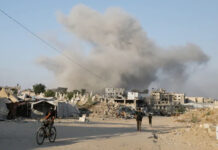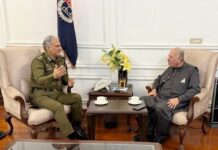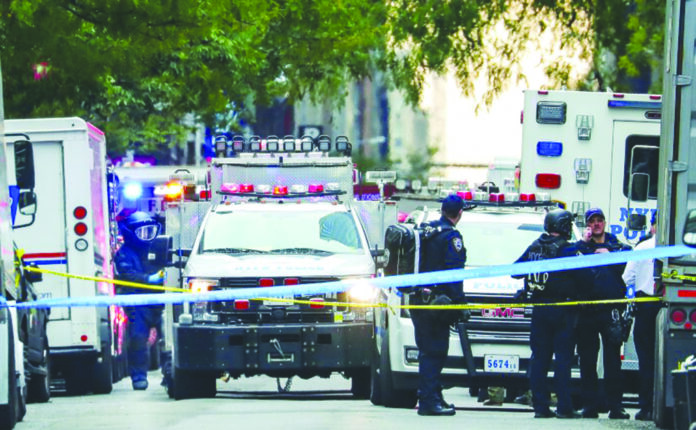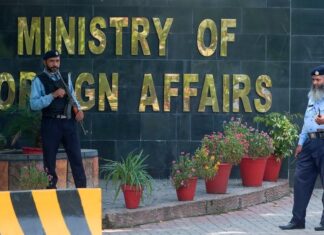Terrorism has cast a long and troubling shadow over Pakistan, a menace that began to manifest with macabre intensity in the late 1970s and early 1980s. This period was a crucible of cataclysmic events: the Soviet-Afghan war, the Iranian revolution, subsequent role of Pakistan in supporting the Afghan Mujahedeen and the emergence of sectarian violence in Pakistan.
Following the conclusion of the Soviet-Afghan war, Pakistan witnessed the influx of large numbers of battle-hardened militants from various parts of the Muslim world. The state’s failure to effectively disarm and demobilize these combatants led to the proliferation of private militias and increased sectarian violence. Over time, these elements entrenched themselves in the national fabric, giving rise to religious extremism and domestic terrorism. Nevertheless, radicalization has been stoked and violence has been justified by the spread of extreme doctrines, frequently via unapproved media and specific schools of thought.
Although the state has launched multiple military operations, such as Operation Al-Mizan (2002-2006), Operation Rah-e-Haq (2007-2009), Operation Sher Dil ( 2008-2009), Operation Rah-e-Rast (May-July 2009), Operation Rah-e-Nijat (2009), Operation Zarb-e-Azb (2014-2016), Operation Khyber Series (2014-2017), Operation Radd-ul-Fasaad (2017), Azm-e-Istehkam (2024), ranging from the Swat Valley to the tribal regions of South and North Waziristan, it is increasingly apparent that kinetic action alone is insufficient. Tactical victories cannot eliminate terrorism without addressing the ideological foundations and environments that enable radicalisation. Moreover, the Ministry of Interior proscribed 82 organizations under section 11-B (1), ATA 1997 in order to exterminate the clout of militant organizations.
Evidently, socioeconomic hardship, political exclusion and a strong sense of grievance are frequently the fundamental causes of the ideological pull of militancy. In fact, the origins of contemporary transnational Jihadism can be traced back to the Soviet involvement in Afghanistan in 1979. After losing the Vietnam War and being embroiled in the Cold War, the USA strategically mobilized Afghan resistance through Pakistan. As a result, the idea of jihad was actively promoted and used as a tool in this endeavor. The USA and Saudi Arabia provided the majority of the funding for the training and deployment of thousands of foreign combatants to the Afghan front. This contributed to the USSR’s exhaustion of determination, but it left a volatile legacy. However, the USA abruptly withdrew from the region after the USSR’s exit, making minimal investments in disarmament and rehabilitation.
Ultimately, the abrupt withdrawal of foreign support directly led to a generation of armed, ideologically motivated and battle-hardened militant fighters who were suddenly without a battlefield. Consequently, many of these individuals swiftly redirected their focus to other pressing Muslim issues around the world, including Chechnya, Palestine, and Kashmir, thus internationalizing their struggle. It was out of this precarious vacuum that Al-Qaeda tragically emerged.
However, it was only in the devastating aftermath of the 9/ 11 attacks that the world was jolted into significant action. This horrific event fundamentally shifted the focus toward combating the intellectual underpinnings of terrorism. Furthermore, an important turning point in Pakistan’s internal security was the 2007 Lal Masjid operation. This action was followed by a sharp increase in militant activity.
Over 3,000 people died as a result of suicide attacks, which increased from 22 in 2006 to 56 in 2007. This led to a surge of retaliatory violence throughout Pakistan, destroying both urban and tribal areas, intensifying radicalization and encouraging the recruitment of militants. In response, Pakistan proactively launched comprehensive de-radicalization initiatives, specifically designed to rehabilitate captured militants, systematically dismantle extremist narratives and proactively promote inclusive counter-ideologies that nurture moderation and tolerance.
It is imperative to widely conduct various deradicalization programs and successfully disseminate the peace narrative of “Paigham-e-Pakistan” in order to demystify the flawed ideological underpinnings of terrorists. However, the crucial role of police cannot be ignored in the counter terrorism efforts. Therefore, it is essential to work on disseminating counter narratives, reinforcing deradicalization efforts, equipping the police capacity along with adopting the hard measures.
These programmes aim to undercut the appeal of violent ideologies by creating doubt within extremist ranks, offering rehabilitation pathways and addressing root causes such as poverty, unemployment and lack of education. The ideological battlefield is as critical as the military one. Misinterpretations of religious texts, exploitative narratives, government missteps, drone warfare and social inequalities all contribute to the radicalisation process. Countering extremist messaging requires strong theological leadership, particularly in societies where the clergy wield influence. In Pakistan, the fatwa remains a powerful tool, yet it often exists in a grey legal zone. A state-supported religious counter-narrative, aligned with constitutional values, is essential to delegitimizing violent ideologies.
Pakistan, situated along a porous and volatile border with Afghanistan, faces unique challenges. After 9/11, it assumed the role of a frontline state in the US-led Global War on Terror. The consequences have been profound. According to data from the South Asia Terrorism Portal (SATP), from 2003 to 2023, Pakistan recorded over 25,000 terrorism-related fatalities. These include approximately 9,000 security personnel and 16,000 civilians. The economic cost has been equally staggering. The Ministry of Finance estimates that the cumulative losses, both direct and indirect, exceed $150 billion since 2001.
As many as 284 terrorist attacks have been recorded in KP in 2025, with North Waziristan being the pivot point. The majority of these losses have been borne by regions such as Khyber Pakhtunkhwa and Balochistan, where insurgency and extremism remain acute. However, Afghanistan’s continuous unrest and violence, especially the Taliban’s 2021 comeback, have had a direct effect on Pakistan by giving organizations like the TTP a safe haven and a base of operations from which to launch attacks into Pakistan.
In recent years, the threat has further evolved with a resurgence of ethno-nationalist violence, particularly in Balochistan. Groups such as the Balochistan Liberation Army (BLA) have intensified their operations, targeting infrastructure, security forces and foreign nationals. Analysts increasingly regard the BLA as a significant internal security threat, comparable in impact to religious extremist outfits like the Tehrik-i-Taliban Pakistan (TTP), Hizb-ut-Tahrir (HuT) Islamic State-Khorasan group (IS-K) and Fitna Al Khwaraj (FAK).
Separately, urban terrorism has seen an uptick in cities such as Karachi, while Punjab, though historically less volatile, is no longer immune. Data from 2023 and early 2024 shows a concerning increase in fatalities and attacks across these regions, underscoring the growing complexity of Pakistan’s internal security landscape.
Undoubtedly, terrorism in Pakistan has been made worse by the regional geopolitical rivalries and proxy wars, which have occasionally resulted in state and non-state actors using militant groups to further their nefarious goals. Pakistan grappled with international criticism for its counterterrorism efforts, which has urged the country to stop money laundering and terrorist financing to come out of the stranglehold of FATF in 2022. What emerges is a deeply rooted and multi-faceted challenge. Military operations may remove immediate threats, but the broader ideological and socio-political dimensions of extremism must be confronted to achieve lasting peace.
The war on terror cannot be won solely with guns and bullets; it must also be waged in schools, pulpits, mainstream and regional media and diverse policymaking forums. This requires a calibrated strategy encompassing law enforcement reforms, community engagement, educational overhaul, religious reformation and economic justice. Without such integrated measures, the cycle of violence is likely to persist, undermining national cohesion and endangering the country’s long-term stability.
Nevertheless, Pakistan’s anti-terrorism legislative framework has been greatly strengthened. Prosecution and funding are the focus of amendments to the Anti-Terrorism Act (ATA) and improved Counter-Financing of Terrorism (CFT) laws. The extensive National Action Plan (NAP), which was implemented after 2014, highlights a resolute, multifaceted national determination by guiding initiatives to destroy terrorist networks, combat extremist narratives, reform the madrassas, control borders, and strengthen law enforcement capabilities.
Furthermore, it is imperative to widely conduct various deradicalization programs and successfully disseminate the peace narrative of “Paigham-e-Pakistan” in order to demystify the flawed ideological underpinnings of terrorists. However, the crucial role of police cannot be ignored in the counter terrorism efforts. Therefore, it is essential to work on disseminating counter narratives, reinforcing deradicalization efforts, equipping the police capacity along with adopting the hard measures.























Excellent.
So insightful
Writer has sound grip on topic & language.
اللہ کرے زور قلم اور ۔۔۔
The TTP never intended to take over Pakistan, even though they easily could/can.
They established themselves in Dec 2007 and they did what they did for the sole purpose of causing fitna.
This is why Baitullah Mehsud and Hakimullah Mehsud died like dogs instead of as martyrs.
In 2009, the TTP had taken over 80% of Swat and they were on their way to reaching Islamabad, but instead of keeping the momentum going, they agreed to a very counter-productive ceasefire with Pakistan where in exchange for Pakistan recognizing the territories they control and allowing them to govern those areas according to Sharia law, the TTP would halt their advance.
The TTP gave those territories away to Pakistan under the excuse that the Pakistani army launched a surprise offensive against them which they did not expect and because their militants were walking the streets unarmed instead of being armed in the jungles and mountains.
When the 2011 Mumbai attacks happened, and India threatened to respond to Pakistan, Hakimullah Mehsud warned India not to do that, saying if war erupted between India and Pakistan, the TTP would fight alongside Pakistan against India because Pakistanis are Muslim while India is kafir/Hindu.
The TTP should have been / should be quickly dealt with by killing every single Mehsud man, woman, and child.